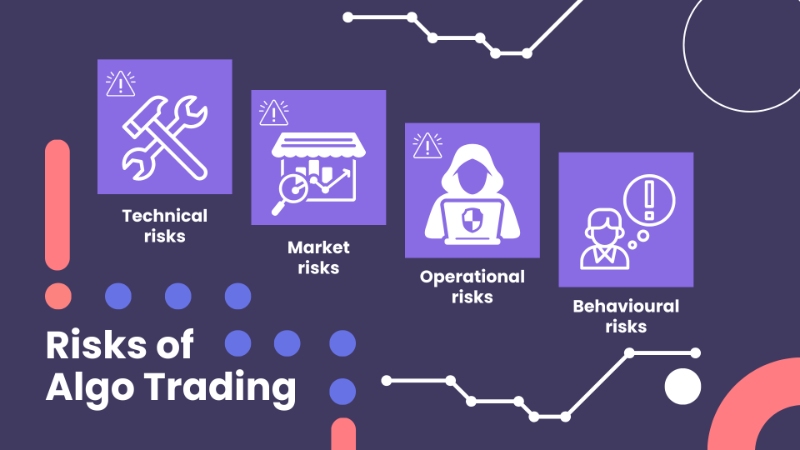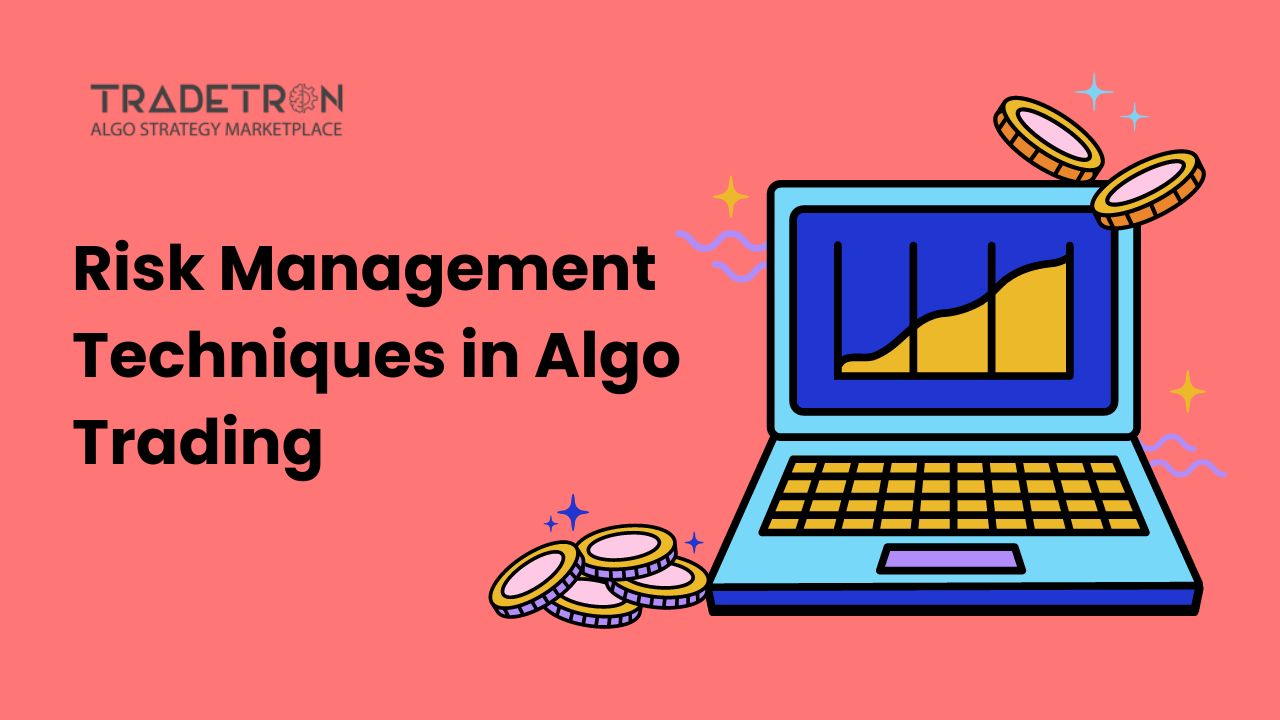Contents
- What Are Some of the Risks of Algo Trading?
- Principles of Risk Management in Algo Trading
- Setting clear investment goals and risk tolerance
- Diversifying investments and avoiding overconcentration
- Regularly monitoring and evaluating performance
- Setting stop-loss and profit-taking levels
- Implementing risk mitigation strategies such as hedging and position sizing
- Conducting thorough research and due diligence on trading strategies and markets
- Risk Management Techniques in Algo Trading
- Stop-loss orders and take-profit orders
- Trailing stops and dynamic position sizing
- Portfolio diversification and rebalancing
- Hedging strategies, such as options and futures
- Quantitative risk management techniques, such as value at risk and stress testing
- Choosing an Algo Trading Platform with Strong Risk Management Features
- Frequently Asked Questions about the Importance Of Risk Management In Algo Trading
- What is the primary objective of risk management in algo trading?
- How can I determine my risk tolerance?
- Is diversification essential in algo trading?
- Can I use stop-loss orders in algo trading?
- How often should I review my risk management plan?
- Why is backtesting important in risk management?
- Conclusion
Algo trading has revolutionised the world of finance by enabling traders to make faster and more informed decisions.
However, the benefits of this trading method come with their share of responsibilities.
The high pace and volume of the trades involved in algorithmic trading make it more risk-prone.
That makes it crucial for algo traders to understand and manage the inherent risks of the system with alertness and caution.
Risks in algo trading can arise from various factors such as programming errors, data inaccuracies, or market fluctuations.
Having a solid risk management strategy in place is therefore essential to prevent these risks from resulting in losses.

In the fast-paced world of financial markets, algorithmic trading has gained significant popularity for its efficiency and speed.
However, with the immense potential for profits, it also comes with inherent risks.
Risk management plays a crucial role in safeguarding your investments and ensuring the long-term success of algo trading strategies.
In this blog, we will delve into the importance of understanding and managing risk in algo trading environments.
We will explore both the different types of risks involved as well as the strategies necessary to manage those risks.
We'll also highlight some of the best practices and tools that traders can use to minimise risk and maximise profitability in their algorithmic trading strategies.
What Are Some of the Risks of Algo Trading?
Algo trading can potentially bring in significant profit for traders, but the process has inherent risks that must be carefully managed.
There are four types of risks involved in algo trading, and having a clear understanding of each of them is essential to develop a robust risk management strategy.
Let’s get into the risk types.
Technical risks
Technical risks arise from system failures, data inaccuracies, and programming errors.
These issues can cause the trading algorithm to generate incorrect signals, leading to poor trading decisions and significant losses.
To mitigate technical risks, traders must perform regular maintenance and testing to ensure that their algorithms function correctly.
Market Risks
Market risk is associated with unexpected events, price fluctuations, and volatility.
For example, a change in interest rates or a geopolitical event like the Russia-Ukraine conflict can significantly impact market prices.
For unprepared traders, this would likely result in losses.
Managing market risks requires traders to use risk management tools like stop-loss orders or diversify their portfolios to spread their exposure across different markets and instruments.
Operational risks
Operational risks include those emanating from issues related to regulatory compliance, cybersecurity, and liquidity.
Regulatory compliance risks arise from non-compliance with regulations, which can result in fines or legal action.
Cybersecurity risks refer to the possibility of a data breach or ransomware attack, which can result in the loss of sensitive information or trading capital.
Liquidity risks arise from the inability to buy or sell assets in the market, which can result in significant losses.
To effectively manage these operational risks, traders must stay up-to-date with regulations, implement advanced cybersecurity measures, and maintain adequate liquidity in their trading accounts.
Behavioural risks
Behavioural risks refer to those that can result from emotional biases, overconfidence, or herding practices (copying trades made by other investors).
These risks can lead traders to make irrational decisions, such as failure to backtest trading strategies, holding onto losing trades for too long, or entering trades based on rumours and social media chatter.
To manage behavioural risks, traders need to implement discipline in their trading strategies and use risk management tactics like position sizing to control their exposure to the market.
The Importance of Risk Management
In algo trading, risk management refers to the set of strategies and practices aimed at identifying, assessing, and mitigating potential risks associated with trading algorithms.
Effective risk management is essential to protect capital, preserve profits, and avoid catastrophic losses.
Principles of Risk Management in Algo Trading
Having a set of well-defined risk management principles can allow algo traders to formulate a cohesive risk management philosophy that functions irrespective of the prevailing market conditions.
Here are some of the key principles of risk management in algo trading:
Setting clear investment goals and risk tolerance
First, set clear investment goals and risk tolerance limits.
This involves defining both the investment returns you expect to achieve as well as the level of risk that you are comfortable with.
This can help ensure that your overall trading strategy is always aligned with your financial goals and risk appetite.
Diversifying investments and avoiding overconcentration
Spreading out your trades by diversifying your investments helps you avoid overconcentration, and is another key principle of risk management in algo trading.
It involves making investments across different asset classes and markets to minimise exposure to individual risks.
This can help reduce the impact of market fluctuations on your portfolio and increase the likelihood of achieving your investment goals.
Regularly monitoring and evaluating performance
Once again, this is critical to managing risk effectively in algo trading.
Performance monitoring and evaluation involves tracking your record against set investment goals and risk tolerance limits and adjusting your trading strategy accordingly.
Regular monitoring allows you to identify issues early and take corrective actions before they lead to losses.
Setting stop-loss and profit-taking levels
This is a smart strategy that involves setting price points that trigger the automatic buying or selling of assets once prices go above or below pre-set levels.
Setting stop-loss and profit-taking levels is a proven way to minimise trading risks.
It is also effective in reducing emotional biases that can creep into trading decisions.
Implementing risk mitigation strategies such as hedging and position sizing
Hedging involves taking positions that offset potential losses in other positions.
Position sizing involves determining the appropriate amount to invest in each trade based on the level of risk and expected returns.
Both of them are proven risk mitigation strategies in traditional as well as algo trading situations.
Conducting thorough research and due diligence on trading strategies and markets
Conducting research and due diligence on trading strategies allows traders to make well-rounded and informed investment decisions.
The process involves gathering relevant market information, evaluating the effectiveness of trading strategies, and identifying all potential risks and opportunities involved in a trade.
Risk Management Techniques in Algo Trading

Here are some important risk management techniques that algo traders should be aware of,
Stop-loss orders and take-profit orders
As we’ve seen above, stop-loss and take-profit orders are common techniques used in algo trading to manage risk.
Stop-loss orders are set to automatically sell a position when it reaches a certain price, limiting potential losses.
Take-profit orders, conversely, are set to sell a position once it breaches a pre-set price point, locking in profits.
These orders help traders limit their downside risk while ensuring they capture their desired profits.
Trailing stops and dynamic position sizing
Trailing stops and dynamic position sizing are risk management techniques that can prove vital in algo trading.
Trailing stops are stop-loss orders that move with the market price, protecting profits and limiting losses.
Dynamic position sizing involves adjusting the size of positions based on market conditions, reducing exposure to high-risk assets and increasing exposure to low-risk assets.
Portfolio diversification and rebalancing
Portfolio diversification involves spreading investments across different assets and markets to reduce exposure to individual risks.
Rebalancing involves periodically adjusting portfolio weights to maintain a target asset allocation, ensuring the portfolio remains diversified and aligned with the trader's risk tolerance and investment goals.
Hedging strategies, such as options and futures
Hedging strategies, such as options and futures, are a common technique in algo trading risk management.
Hedging involves taking positions that offset potential losses in other positions.
For example, if a trader has a long position in a particular asset, they may take a short position in a related asset to offset potential losses.
Quantitative risk management techniques, such as value at risk and stress testing
Quantitative risk management techniques, such as value at risk (VaR) and stress testing, represent advanced risk management techniques.
VaR is a statistical technique used to estimate the potential losses of a portfolio over a specified period at a given confidence level.
Stress testing involves simulating extreme market scenarios to assess the potential impact on a portfolio.
Investors may also choose to live-test and backtest trading algorithms before deployment.
Choosing an Algo Trading Platform with Strong Risk Management Features
Implementing strong risk management principles and techniques is paramount in the context of algo trading.
The volatile and complex nature of markets makes it essential for you to have effective risk management strategies to minimise losses and improve overall performance.
Algo traders can better manage risks and increase their chances of success by setting clear investment goals, diversifying investments, regularly monitoring performance, implementing risk mitigation strategies, and conducting thorough research.
Failure to implement these principles and techniques can result in significant losses and damage to market reputations.
It’s important to prioritise risk management in algo trading to improve overall performance and ensure long-term success.
At Tradetron, we believe in helping traders make the most rational and well-rounded decisions in dealing with market risks.
Together with other tools, our detailed performance analysis reports allow users to actively spot and solve discrepancies within their trading strategies to manage investment risks effectively.
Visit us to learn more about how we empower traders to make better, risk-free investments.
Frequently Asked Questions about the Importance Of Risk Management In Algo Trading
What is the primary objective of risk management in algo trading?
The primary objective of risk management in algo trading is to protect capital and manage potential losses.
How can I determine my risk tolerance?
Assess your financial goals, investment horizon, and comfort level with potential losses to determine your risk tolerance.
Is diversification essential in algo trading?
Yes, diversification helps spread risk across different trades and asset classes, reducing exposure to individual market movements.
Can I use stop-loss orders in algo trading?
Yes, implementing stop-loss orders is a common risk management technique to limit potential losses.
How often should I review my risk management plan?
Regularly review your risk management plan, ideally after significant market events or changes in trading strategies.
Why is backtesting important in risk management?
Backtesting allows you to assess how your trading strategies perform under historical market conditions, identifying potential risks and improving strategy efficacy.
How to manage risk in trading?
Managing risk in trading is crucial for success and longevity in the financial markets. While no strategy can completely eliminate risk, there are several effective ways to manage and mitigate it.
Here's a concise guide on how to navigate the risky waters of trading:
1. Develop a Solid Trading Plan
A well-thought-out trading plan is your roadmap to success. It should include clear goals, risk tolerance levels, entry/exit strategies, and position sizing guidelines.
Stick to your plan religiously and avoid impulsive decisions driven by emotions.
2. Diversify Your Portfolio
Spreading your investments across different asset classes or sectors can help reduce the impact of individual trades gone wrong.
Diversification ensures that losses from one trade can be offset by gains from others.
3. Implement Stop Loss Orders
Placing stop loss orders is an essential risk management technique that automatically exits a trade if it reaches a predetermined price level or percentage loss threshold.
This protects you from substantial losses during unexpected market movements.
4. Utilize Position Sizing Techniques
Determine how much capital you are willing to allocate per trade based on your overall portfolio size and risk appetite.
Avoid risking more than 1-2% of your total account balance on any single trade.
5. Perform Thorough Research & Analysis
Educate yourself about the instruments you're trading, stay updated with relevant news and events, analyze technical indicators, charts, and economic data before entering into any position.
Proper research helps identify potential risks ahead of time.
6. Be Mindful of Leverage
Leverage amplifies both profits and losses in trading significantly; therefore, use it judiciously according to your risk tolerance level when utilizing margin accounts or derivatives instruments such as options or futures contracts.
7.Risk-Reward Ratio Evaluation
Each trade should have a favorable risk-reward ratio where potential profit outweighs potential loss substantially (e.g., at least 3 times).
This ensures that even if a few trades result in losses, overall profitability is maintained.
8. Regularly Review & Adjust Your Strategy
Market conditions change frequently, so periodically evaluate the performance of your trading strategy and make necessary adjustments.
This ensures it remains aligned with current market dynamics.
9. Emotional Discipline
Emotions like fear and greed can cloud judgment and lead to impulsive or irrational decision-making.
Maintaining emotional discipline is crucial for managing risk effectively.
Avoid chasing losses or entering into trades without proper analysis.
10. Continuously Monitor & Manage Risk Exposure
Stay vigilant and actively manage your trades by monitoring positions daily, setting trailing stops as trade progresses, booking profits at predetermined targets, or tightening stop-loss levels when appropriate.
Conclusion
Risk management in algo trading is a vital aspect of achieving long-term success in the financial markets.
By understanding the basics, key components, and best practices of risk management, you can mitigate potential risks and protect your investments.
Algorithmic trading can offer significant opportunities, but prudent risk management is the cornerstone of sustainable profitability.
Embrace risk management strategies, remain disciplined, and continually adapt to evolving market conditions to excel in the world of algo trading.



 Made with Superblog
Made with Superblog